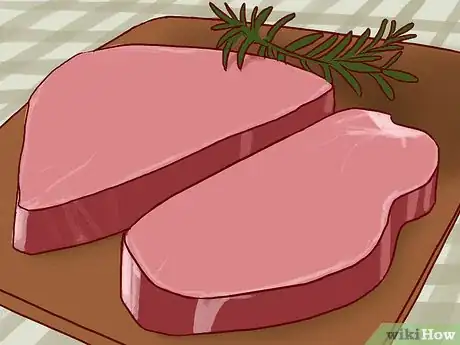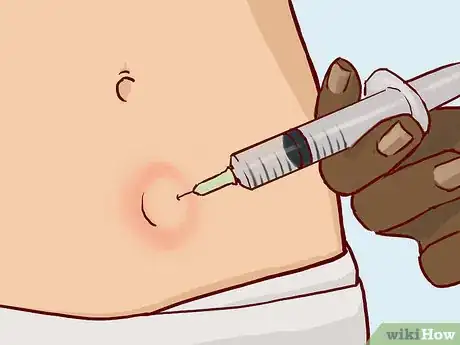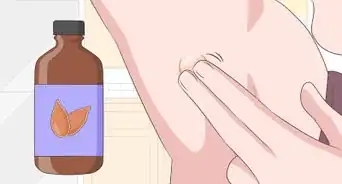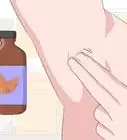This article was co-authored by Zora Degrandpre, ND. Dr. Zora Degrandpre is a Natural Health Doctor and Licensed Naturopathic Physician in Vancouver, Washington. She is a grant reviewer for the National Institutes of Health and the National Center for Complementary and Alternative Medicine. She received her ND from the National College of Natural Medicine in 2007.
There are 13 references cited in this article, which can be found at the bottom of the page.
wikiHow marks an article as reader-approved once it receives enough positive feedback. This article received 14 testimonials and 100% of readers who voted found it helpful, earning it our reader-approved status.
This article has been viewed 624,435 times.
A lipoma is a benign (non-cancerous) overgrowth of fatty tissues that usually grows on your neck, shoulders, abdomen, arms, thighs, or back. Lipomas are painless, harmless, and very slow-growing. Located between the skin and the muscle, they will feel spongy and will move freely under your skin. Although lipomas are harmless, they can limit your range of motion and may alter your appearance. Fortunately, you can try natural treatments to shrink your lipomas. However, seek medical attention if you experience pain, see new lumps, or have problems with your range of motion.[1]
Steps
Treating Lipomas with Natural Oils and Herbs
-
1Create an ointment using natural oils and herbs. Natural oils such as neem and flaxseed make excellent base for ointments. Experiment with different combinations of herbs and oils.
- Neem oil is an astringent that helps protect your skin. It is commonly used in Ayurvedic (ancient Indian) medicine to treat lipomas.[2]
- Flaxseed oil has high levels of omega-3 and omega-6 fatty acids. Omega-3 and omega-6 fatty acids help to reduce inflammation. Be sure to buy flaxseed oil certified to be free of heavy metals, such as lead and mercury.
Tip: While not a natural oil, cooled green tea is a great alternative for your base. It is high in antioxidants that help regulate blood sugar and blood fats.
-
2Mix chickweed with a natural oil or tea base. Blend 1 teaspoon of chickweed to 2-3 tablespoons of neem oil or flaxseed oil. Apply the salve to the lipoma.
- Chickweed is used to reduce fats.[3]
- You can also use 1-2 tablespoons of cooled green tea instead of neem or flaxseed oil to make a paste.
Advertisement -
3Try creating an ointment with turmeric. Put 1 teaspoon of turmeric together with 2-3 tablespoons of neem oil or flaxseed oil. Smooth the ointment onto the lipoma. Your skin will turn a bit orange or yellow because of the turmeric. Cover the lipoma with a bandage to protect your clothes.[4]
- Turmeric, like neem oil, is commonly used in Ayurvedic medicine.
- For a paste, add 1-2 tablespoons of cooled green tea instead of neem or flaxseed oil to the turmeric.
-
4Add dried sage to neem oil or flaxseed oil. Mix ½ to 1 teaspoon of dried sage with 2-3 tablespoons of neem oil or flaxseed oil. Coat the lipoma with the balm.
- Substitute 1-2 tablespoons of cooled green tea for neem or flaxseed oil to make a paste.
- Sage is used in traditional Chinese medicine to dissolve fatty tissue.[5]
Making Dietary Changes
-
1Increase the amount of vegetables and fruits in your diet. Fruits and vegetables have antioxidants which help lower fats in the blood.[6]
- Choose brightly colored fruits and vegetables for the highest level of antioxidants. Some great examples of fruits and vegetables high in antioxidants are blueberries, raspberries, apples, plums, citrus fruits, leafy green vegetables, squash and bell peppers.
-
2Eat more fish. Fish has good amounts of healthy omega-3 fats and good quality protein. Omega-3 fats help to decrease inflammation and may help limit the growth of lipomas.[7]
-
3Limit eating red meats. If you do eat red meat, make sure it is grass-fed with no added antibiotics or hormones. Grass-fed meat has a lot of healthy omega-3 and omega-6 fats.[11]
- Chicken, tofu, and beans are all healthy alternatives to red meat that are also high in protein.
-
4Switch to organic foods as much as possible. Switching to organic foods reduces the number of preservatives and additives you eat. Your liver will then be able to focus on removing the toxins stored in the lipoma’s fatty tissue.
Did You Know? Limiting the amount of processed and pre-packaged foods you eat will also limit the amount of additives and preservatives in your diet.
When to Seek Medical Treatment
-
1See your doctor if you feel pain or discomfort, have a new lump, or see swelling. It’s possible for a lump to look like a lipoma but really be something else. Since lipomas aren’t painful, experiencing pain might be a sign that your lump is something else. Similarly, it’s best not to try treating a new lump or an area of swelling until you’ve had it checked by a doctor.[12]
- Your lump is most likely not a cause for worry, but it’s good to be sure that it’s a lipoma rather than something else.
-
2Expect your doctor to do a tissue biopsy and an X-ray, MRI or CT scan. These tests will help your doctor make sure what you have is really a lipoma. In most cases, your doctor will do your diagnostic tests quickly in their office.[13]
- You shouldn’t feel any pain when your doctor takes a biopsy, but you may experience discomfort. Before taking a biopsy, your doctor will numb the area around the lipoma. Then, they’ll use a thin needle to take a small sample from the lump. Finally, they’ll examine the sample under a microscope to make sure it’s a lipoma.
- The X-ray, MRI, and CT scan are all imaging tests. In most cases, your doctor will just do one of them. An X-ray can show a shadow where the lipoma is located, while an MRI and CT scan can show the lipoma in more detail.[14]
-
3Ask your doctor if liposuction can treat a lipoma that’s bothering you. If you have a small lipoma that is interfering with your daily life, your doctor may be able to remove it using liposuction. To do this procedure, your doctor will administer a numbing agent near the lipoma so you won’t feel pain. Then, they’ll use a needle to suck out the fatty tissue in the lipoma.[15]
- This simple procedure is quick and doesn’t require much downtime. However, you might experience soreness, discomfort and bruising.
-
4Consider surgical removal if the lipoma restricts your movement. If your doctor thinks surgery is the right option for you, they’ll usually sedate your before surgery. To remove the lipoma, they’ll make a small incision and then extract the lipoma from your body. Finally, they’ll stitch up the incision.[16]
- After surgery, you may have some scarring around the area. However, the scar likely won’t be very noticeable. Additionally, discomfort and bruising are common in the days after surgery.
- You might also consider surgery if the lipoma is affecting how you feel about your appearance.
Tip: If you get your lipoma surgically removed, it’s very unlikely that it will come back.
Expert Q&A
-
QuestionHow can I increase the hemoglobin level in my blood?
 Zora Degrandpre, NDDr. Zora Degrandpre is a Natural Health Doctor and Licensed Naturopathic Physician in Vancouver, Washington. She is a grant reviewer for the National Institutes of Health and the National Center for Complementary and Alternative Medicine. She received her ND from the National College of Natural Medicine in 2007.
Zora Degrandpre, NDDr. Zora Degrandpre is a Natural Health Doctor and Licensed Naturopathic Physician in Vancouver, Washington. She is a grant reviewer for the National Institutes of Health and the National Center for Complementary and Alternative Medicine. She received her ND from the National College of Natural Medicine in 2007.
Natural Health Doctor Hemoglobin is an iron containing molecule found in red blood cells. Hemoglobin carries oxygen to the cells and carries carbon dioxide to the lungs for excretion. The best way to increase hemoglobin levels is to increase the amounts of fresh fruits, vegetables and lean protein in your diet. Also include foods rich in iron such as lean red meats, dark, leafy green vegetables, beans and poultry.
Hemoglobin is an iron containing molecule found in red blood cells. Hemoglobin carries oxygen to the cells and carries carbon dioxide to the lungs for excretion. The best way to increase hemoglobin levels is to increase the amounts of fresh fruits, vegetables and lean protein in your diet. Also include foods rich in iron such as lean red meats, dark, leafy green vegetables, beans and poultry.
Warnings
- None of the herbal treatments listed here have been scientifically studied. Evidence may be anecdotal in nature and should not replace medical evaluation and treatment.⧼thumbs_response⧽
References
- ↑ http://www.mayoclinic.org/diseases-conditions/lipoma/basics/symptoms/con-20024646
- ↑ https://www.drugs.com/npc/neem.html
- ↑ Rani, N., Vasudeva, N., & Sharma, S. K. (2012). Quality assessment and anti-obesity activity of Stellaria media (Linn.) Vill. BMC Complementary And Alternative Medicine, 12145. doi:10.1186/1472-6882-12-145.
- ↑ http://www.earthclinic.com/cures/lipoma.html
- ↑ Wood, M. The Earthwise Herbal: A Complete Guide to Old World Medicinal Plants, 2008
- ↑ http://www.ncbi.nlm.nih.gov/pubmed/9216565
- ↑ Fritsche KL.The science of fatty acids and inflammation. Adv Nutr. 2015 May 15;6(3):293S-301S
- ↑ http://www.heart.org/HEARTORG/GettingHealthy/NutritionCenter/HealthyDietGoals/Fish-and-Omega-3-Fatty-Acids_UCM_303248_Article.jsp
- ↑ http://www.askdrsears.com/topics/feeding-eating/family-nutrition/fish/ranking-seafood-which-fish-are-most-nutritious
- ↑ http://www.askdrsears.com/topics/feeding-eating/family-nutrition/fish/ranking-seafood-which-fish-are-most-nutritious
- ↑ Byelashov OA, Sinclair AJ, Kaur G., Dietary sources, current intakes, and nutritional role of omega-3 docosapentaenoic acid. Lipid Technol. 2015 Apr;27(4):79-82.
- ↑ https://www.mayoclinic.org/diseases-conditions/lipoma/symptoms-causes/syc-20374470
- ↑ https://www.mayoclinic.org/diseases-conditions/lipoma/diagnosis-treatment/drc-20374474
- ↑ https://orthoinfo.aaos.org/en/diseases--conditions/lipoma
- ↑ https://www.mayoclinic.org/diseases-conditions/lipoma/symptoms-causes/syc-20374470
- ↑ https://www.mayoclinic.org/diseases-conditions/lipoma/diagnosis-treatment/drc-20374474
About This Article
To treat lipomas naturally, increase the amount of fruits and vegetables in your diet since the antioxidants will help lower fats in your blood. In addition to eating more produce, eat more fish, which has healthy omega-3 fats and protein, which can decrease inflammation and limit the growth of lipomas. Another method for treating lipomas is creating an ointment made from neem or flaxseed and chickweed or tumeric. Apply the salve to the lipomas to help reduce fatty tissue and inflammation. For more tips from our Medical co-author, including how to eat organic foods to treat lipomas, keep reading!










































































Medical Disclaimer
The content of this article is not intended to be a substitute for professional medical advice, examination, diagnosis, or treatment. You should always contact your doctor or other qualified healthcare professional before starting, changing, or stopping any kind of health treatment.
Read More...